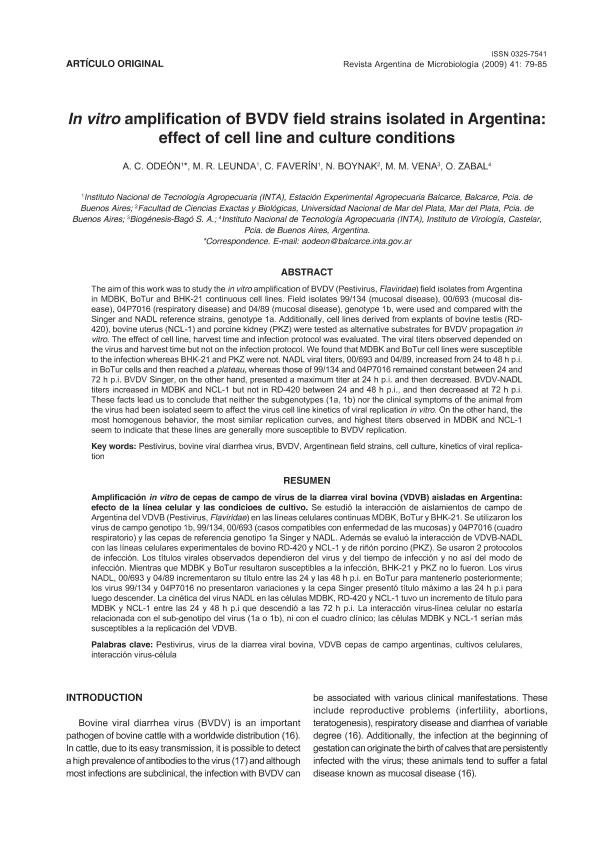Artículo
The aim of this work was to study the in vitro amplification of BVDV (Pestivirus, Flaviridae) field isolates from Argentina in MDBK, BoTur and BHK-21 continuous cell lines. Field isolates 99/134 (mucosal disease), 00/693 (mucosal disease), 04P7016 (respiratory disease) and 04/89 (mucosal disease), genotype 1b, were used and compared with the Singer and NADL reference strains, genotype 1a. Additionally, cell lines derived from explants of bovine testis (RD-420), bovine uterus (NCL-1) and porcine kidney (PKZ) were tested as alternative substrates for BVDV propagation in vitro. The effect of cell line, harvest time and infection protocol was evaluated. The viral titers observed depended on the virus and harvest time but not on the infection protocol. We found that MDBK and BoTur cell lines were susceptible to the infection whereas BHK-21 and PKZ were not. NADL viral titers, 00/693 and 04/89, increased from 24 to 48 h p.i. in BoTur cells and then reached a plateau, whereas those of 99/134 and 04P7016 remained constant between 24 and 72 h p.i. BVDV Singer, on the other hand, presented a maximum titer at 24 h p.i. and then decreased. BVDV-NADL titers increased in MDBK and NCL-1 but not in RD-420 between 24 and 48 h p.i., and then decreased at 72 h p.i. These facts lead us to conclude that neither the subgenotypes (1a, 1b) nor the clinical symptoms of the animal from the virus had been isolated seem to affect the virus cell line kinetics of viral replication in vitro. On the other hand, the most homogenous behavior, the most similar replication curves, and highest titers observed in MDBK and NCL-1 seem to indicate that these lines are generally more susceptible to BVDV replication. The aim of this work was to study the in vitro amplification of BVDV (Pestivirus, Flaviridae) field isolates from Argentina in MDBK, BoTur and BHK-21 continuous cell lines. Field isolates 99/134 (mucosal disease), 00/693 (mucosal disease), 04P7016 (respiratory disease) and 04/89 (mucosal disease), genotype 1b, were used and compared with the Singer and NADL reference strains, genotype 1a. Additionally, cell lines derived from explants of bovine testis (RD420), bovine uterus (NCL-1) and porcine kidney (PKZ) were tested as alternative substrates for BVDV propagation in vitro. The effect of cell line, harvest time and infection protocol was evaluated. The viral titers observed depended on the virus and harvest time but not on the infection protocol. We found that MDBK and BoTur cell lines were susceptible to the infection whereas BHK-21 and PKZ were not. NADL viral titers, 00/693 and 04/89, increased from 24 to 48 h p.i. in BoTur cells and then reached a plateau, whereas those of 99/134 and 04P7016 remained constant between 24 and 72 h p.i. BVDV Singer, on the other hand, presented a maximum titer at 24 h p.i. and then decreased. BVDV-NADL titers increased in MDBK and NCL-1 but not in RD-420 between 24 and 48 h p.i., and then decreased at 72 h p.i. These facts lead us to conclude that neither the subgenotypes (1a, 1b) nor the clinical symptoms of the animal from the virus had been isolated seem to affect the virus cell line kinetics of viral replication in vitro. On the other hand, the most homogenous behavior, the most similar replication curves, and highest titers observed in MDBK and NCL-1 seem to indicate that these lines are generally more susceptible to BVDV replication.
In vitro amplification of BVDV field strains isolated in Argentina: effect of cell line and culture conditions
Odeón, Anselmo Carlos; Leunda, Maria Rosa; Faverin, Claudia; Boynak, Natalia ; Vena, M. M.; Zabal, O.
; Vena, M. M.; Zabal, O.
 ; Vena, M. M.; Zabal, O.
; Vena, M. M.; Zabal, O.
Fecha de publicación:
12/2009
Editorial:
Asociación Argentina de Microbiología
Revista:
Revista Argentina de Microbiología
ISSN:
0325-7541
e-ISSN:
1851-7617
Idioma:
Inglés
Tipo de recurso:
Artículo publicado
Clasificación temática:
Resumen
Palabras clave:
Bvdv
,
Cell Culture
,
Kinetics of Viral Replication
,
Argentinean Field Strains
Archivos asociados
Licencia
Identificadores
Colecciones
Articulos(INGEBI)
Articulos de INST.DE INVEST.EN ING.GENETICA Y BIOL.MOLECULAR "DR. HECTOR N TORRES"
Articulos de INST.DE INVEST.EN ING.GENETICA Y BIOL.MOLECULAR "DR. HECTOR N TORRES"
Citación
Odeón, Anselmo Carlos; Leunda, Maria Rosa; Faverin, Claudia; Boynak, Natalia; Vena, M. M.; et al.; In vitro amplification of BVDV field strains isolated in Argentina: effect of cell line and culture conditions; Asociación Argentina de Microbiología; Revista Argentina de Microbiología; 41; 12-2009; 79-85
Compartir



